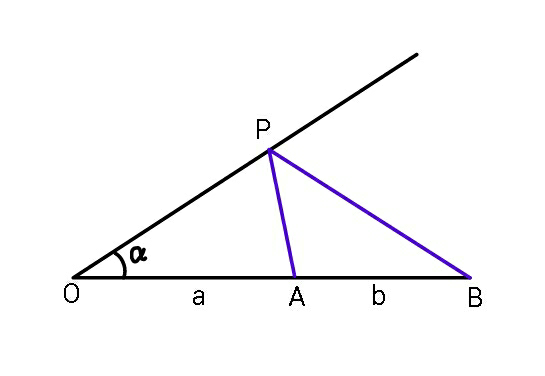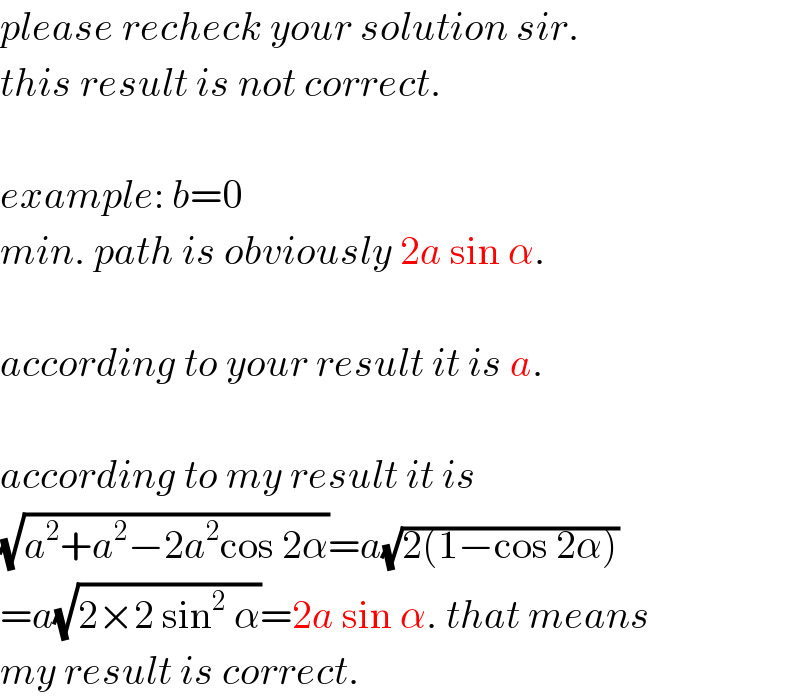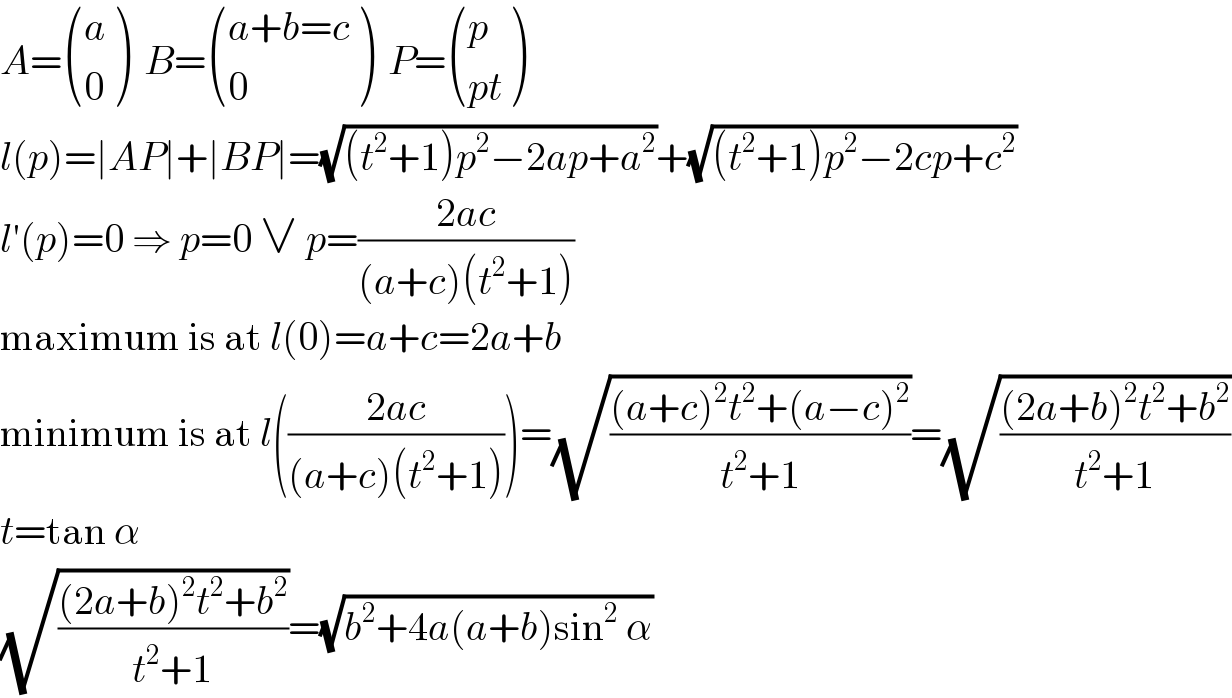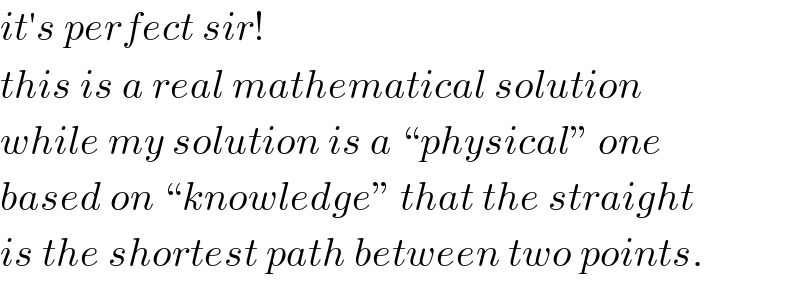Question Number 52061 by ajfour last updated on 02/Jan/19

Commented by ajfour last updated on 02/Jan/19

$${Find}\:{minimum}\:{of}\:\left({AP}+{PB}\right)\:{in} \\ $$$${terms}\:{of}\:\alpha,\:{a},\:{b}. \\ $$
Commented by MJS last updated on 14/Jan/19

$$\mathrm{I}\:\mathrm{get}\:\sqrt{{a}^{\mathrm{2}} +{b}^{\mathrm{2}} −\mathrm{2}{ab}\mathrm{cos}\:\mathrm{2}\alpha} \\ $$
Commented by mr W last updated on 15/Jan/19

$${please}\:{recheck}\:{your}\:{solution}\:{sir}. \\ $$$${this}\:{result}\:{is}\:{not}\:{correct}. \\ $$$$ \\ $$$${example}:\:{b}=\mathrm{0} \\ $$$${min}.\:{path}\:{is}\:{obviously}\:\mathrm{2}{a}\:\mathrm{sin}\:\alpha. \\ $$$$ \\ $$$${according}\:{to}\:{your}\:{result}\:{it}\:{is}\:{a}.\: \\ $$$$ \\ $$$${according}\:{to}\:{my}\:{result}\:{it}\:{is} \\ $$$$\sqrt{{a}^{\mathrm{2}} +{a}^{\mathrm{2}} −\mathrm{2}{a}^{\mathrm{2}} \mathrm{cos}\:\mathrm{2}\alpha}={a}\sqrt{\mathrm{2}\left(\mathrm{1}−\mathrm{cos}\:\mathrm{2}\alpha\right)} \\ $$$$={a}\sqrt{\mathrm{2}×\mathrm{2}\:\mathrm{sin}^{\mathrm{2}} \:\alpha}=\mathrm{2}{a}\:\mathrm{sin}\:\alpha.\:{that}\:{means} \\ $$$${my}\:{result}\:{is}\:{correct}. \\ $$
Answered by mr W last updated on 02/Jan/19

Commented by mr W last updated on 02/Jan/19

$${AP}+{PB}={A}'{P}+{PB} \\ $$$$\left({AP}+{PB}\right)_{{min}} ={A}'{B} \\ $$$$={a}^{\mathrm{2}} +\left({a}+{b}\right)^{\mathrm{2}} −\mathrm{2}{a}\left({a}+{b}\right)\mathrm{cos}\:\left(\mathrm{2}\alpha\right) \\ $$
Commented by ajfour last updated on 15/Jan/19

$$\:{you}\:{mean}\:{of}\:{course}\:\left({A}'{B}\right)^{\mathrm{2}} \:=\:..\:\:\:\: \\ $$
Commented by mr W last updated on 15/Jan/19

$${yes}\:{sir}. \\ $$
Answered by MJS last updated on 15/Jan/19

$${A}=\begin{pmatrix}{{a}}\\{\mathrm{0}}\end{pmatrix}\:\:{B}=\begin{pmatrix}{{a}+{b}={c}}\\{\mathrm{0}}\end{pmatrix}\:\:{P}=\begin{pmatrix}{{p}}\\{{pt}}\end{pmatrix} \\ $$$${l}\left({p}\right)=\mid{AP}\mid+\mid{BP}\mid=\sqrt{\left({t}^{\mathrm{2}} +\mathrm{1}\right){p}^{\mathrm{2}} −\mathrm{2}{ap}+{a}^{\mathrm{2}} }+\sqrt{\left({t}^{\mathrm{2}} +\mathrm{1}\right){p}^{\mathrm{2}} −\mathrm{2}{cp}+{c}^{\mathrm{2}} } \\ $$$${l}'\left({p}\right)=\mathrm{0}\:\Rightarrow\:{p}=\mathrm{0}\:\vee\:{p}=\frac{\mathrm{2}{ac}}{\left({a}+{c}\right)\left({t}^{\mathrm{2}} +\mathrm{1}\right)} \\ $$$$\mathrm{maximum}\:\mathrm{is}\:\mathrm{at}\:{l}\left(\mathrm{0}\right)={a}+{c}=\mathrm{2}{a}+{b} \\ $$$$\mathrm{minimum}\:\mathrm{is}\:\mathrm{at}\:{l}\left(\frac{\mathrm{2}{ac}}{\left({a}+{c}\right)\left({t}^{\mathrm{2}} +\mathrm{1}\right)}\right)=\sqrt{\frac{\left({a}+{c}\right)^{\mathrm{2}} {t}^{\mathrm{2}} +\left({a}−{c}\right)^{\mathrm{2}} }{{t}^{\mathrm{2}} +\mathrm{1}}}=\sqrt{\frac{\left(\mathrm{2}{a}+{b}\right)^{\mathrm{2}} {t}^{\mathrm{2}} +{b}^{\mathrm{2}} }{{t}^{\mathrm{2}} +\mathrm{1}}} \\ $$$${t}=\mathrm{tan}\:\alpha \\ $$$$\sqrt{\frac{\left(\mathrm{2}{a}+{b}\right)^{\mathrm{2}} {t}^{\mathrm{2}} +{b}^{\mathrm{2}} }{{t}^{\mathrm{2}} +\mathrm{1}}}=\sqrt{{b}^{\mathrm{2}} +\mathrm{4}{a}\left({a}+{b}\right)\mathrm{sin}^{\mathrm{2}} \:\alpha} \\ $$
Commented by MJS last updated on 15/Jan/19

$$\mathrm{not}\:\mathrm{sure}\:\mathrm{what}\:\mathrm{happened}\:\mathrm{before}.\:\mathrm{this}\:\mathrm{is}\:\mathrm{correct} \\ $$$$\mathrm{and}\:\mathrm{should}\:\mathrm{be}\:\mathrm{the}\:\mathrm{same}\:\mathrm{as}\:\mathrm{your}\:\mathrm{result} \\ $$
Commented by ajfour last updated on 15/Jan/19

$${Thanks}\:{for}\:{the}\:{alternative}\:{way}\:{Sir}. \\ $$
Commented by mr W last updated on 15/Jan/19

$${it}'{s}\:{perfect}\:{sir}! \\ $$$${this}\:{is}\:{a}\:{real}\:{mathematical}\:{solution} \\ $$$${while}\:{my}\:{solution}\:{is}\:{a}\:“{physical}''\:{one} \\ $$$${based}\:{on}\:“{knowledge}''\:{that}\:{the}\:{straight} \\ $$$${is}\:{the}\:{shortest}\:{path}\:{between}\:{two}\:{points}. \\ $$
Commented by mr W last updated on 15/Jan/19

$${but}\:{anyway},\:{a}\:{maximum}\:{doesn}'{t}\:{exit}. \\ $$
